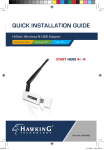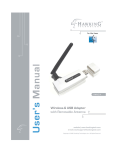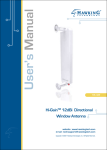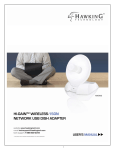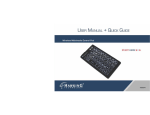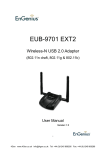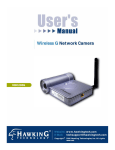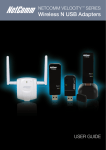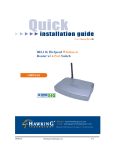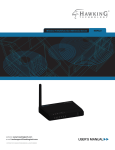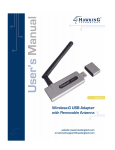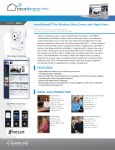Download Hawking Technology HWUN1A User's Manual
Transcript
i LIMITED WARRANTY Hawking Technology guarantees that every HWUN1A Wireless-N USB Adapter with Upgradable Antennas is free from physical defects in material and workmanship under normal use for one (1) year from the date of purchase. If the product proves defective during this two-year warranty period, call Hawking Customer Service in order to obtain a Return Authorization number. Warranty is for repair or replacement only. Hawking Technology does not issue any refunds. BE SURE TO HAVE YOUR PROOF OF PURCHASE. RETURN REQUESTS CAN NOT BE PROCESSED WITHOUT PROOF OF PURCHASE. When returning a product, mark the Return Authorization number clearly on the outside of the package and include your original proof of purchase. IN NO EVENT SHALL HAWKING TECHNOLOGY’S LIABILTY EXCEED THE PRICE PAID FOR THE PRODUCT FROM DIRECT, INDIRECT, SPECIAL, INCIDENTAL OR CONSEQUENTIAL DAMAGES RESULTING FROM THE USE OF THE PRODUCT, ITS ACCOMPANYING SOFTWARE OR ITS DOCUMENTATION. Hawking Technology makes no warranty or representation, expressed, implied or statutory, with respect to its products or the contents or use of this documentation and all accompanying software, and specifically disclaims its quality, performance, merchantability, or fitness for any particular purpose. Hawking Technology reserves the right to revise or updates its products, software, or documentation without obligation to notify any individual or entity. Please direct all inquiries to: [email protected] Trademarks & Copyright All brands and product names are trademarks of their respective companies. No part of this publication may be reproduced in any form or by any means or used to make any derivative (such as translation, transformation or adaptation) without the express written consent of the manufacturer as stipulated by the United States Copyright Act of 1976. Warning Statement: Federal Communication Commission Interference Statement Federal Communications Commission (FCC) Requirements, Part 15 1. Reorient or relocate the receiving antenna. 2. Increase the separation between the equipment and receiver. 3. Connect the equipment into an outlet on a circuit different from that to which the receiver is connected. 4. Consult the dealer or an experienced radio/TV technician for help. This device complies with Part 15 of the FCC Rules. Operation is subject to the following two conditions: (1) This device may not cause harmful interference. (2) This device must accept any interference received, including interference that may cause undesired operation. FCC Caution: FCC RF Exposure Statement: This Transmitter must not be co-located or operating in conjunction with any other antenna or transmitter. This equipment complies with FCC RF radiation exposure limits set forth for an uncontrolled environment. This equipment should be installed and operated with a minimum distance of 20 centimeters between the radiator and your body. Unauthorized antenna, modification, or attachments could damage the transmitter and may violate FCC regulations. Regulatory information/Disclaimers: Any changes or modifications made to this device that are not expressly approved by the manufacturer may void the user's authority to operate the equipment. ii CONTENTS I. II. INTRODUCTION ......................................................................... 1 Features .................................................................................................................... 1 Package Contents ..................................................................................................... 2 INSTALLATION PROCEDURES ............................................... 2 III. CONNECTING TO YOUR WIRELESS NETWORK ................. 6 IV. CONFIGURATION UTILITY ..................................................... 9 1. Site Survey .............................................................................................................. 9 2. Profile ................................................................................................................... 10 3. Link Status ............................................................................................................ 15 4. Statistics ................................................................................................................ 17 5. Advanced .............................................................................................................. 18 6. About .................................................................................................................... 19 V. APPENDIX A - SPECIFICATIONS .......................................... 20 VI. INDEX ........................................................................................ 21 PRODUCT SUPPORT INFORMATION ............................................ 24 iii I. INTRODUCTION Thank you for purchasing the Hawking HWUN1A Wireless-N USB Adapter. Now you can enjoy the latest Wireless-N technology with excellent speeds, of up to 300Mbps*. The Wireless-N USB Adapter extends your wireless network coverage by up to 3 times and boosts transmission throughput 12 times more than a standard Wireless-NNetwork. It allows you to connect a notebook or desktop to any wireless network** using the USB port. Now, you can stream HD video, play games online, download music, images and data while maintaining your freedom of mobility. In addition, the HWUN1A comes with an upgradable antenna option. Replace the default antennas with Hawking Hi-Gain Antennas and you can enjoy extended wireless range. The HWUN1A is also packed with security applications. For more security-sensitive applications, the HWUN1A supports Hardware-based IEEE 802.11i encryption/decryption engine, including 64-bit/128-bit WEP, TKIP, and AES. Also, it supports Wi-Fi alliance WPA and WPA2 encryption. Cisco CCX V1.0, V2.0 and V3.0. Features Features Advantages High Speed Data Rate Up to 300Mbps* Capable of handling heavy data payloads such as MPEG video streaming IEEE 802.11b/g Compliant Fully Interoperable with IEEE 802.11b / IEEE 802.11g compliant devices with legacy protection Supports WPA/WPA2 (IEEE 802.11i), WEP 64/128 bits Powerful & Robust data security. Enables Smart Antennas for more range and speed Dual Radios (2Tx, 2Rx) Wireless Multimedia Quality of Service support (QoS) / enhanced power Saving for Dynamic Networking. WMM (IEEE 802.11e) standard support Upgradable Antenna Design (2X) Flexible with SMA connector design * Theoretical wireless signal rate based on IEEE standard of 802.11a, b, g chipset used. Actual throughput may vary. Network conditions and environmental factors lower actual throughput rate. **Preferably Wireless-N network for maximum throughputs. ** *All specifications are subject to change without notice. 1 Package Contents Before you begin the installation, please check the items of your package. The package should include the following items: - One HWUN1A Wireless-N USB network Adapter - One USB cable (1.0m) - One CD-ROM with User’s Manual & Drivers - Quick Installation Guide - 2 Dipole Antenna (SMA connector) - One Laptop Clip LED indicator Dipole Antennas USB port LED Description LINK Blinks when active connection is available else remains switched OFF Blinks rapidly when data communication in progress else remains PWR II. switched OFF INSTALLATION PROCEDURES Before you proceed with the installation, please notice following descriptions. 2 IMPORTANT: • Please do not install the wireless adapter into your Mac desktop or notebook before installing the software program from the CD. • The following installation was operated under Apple OSX 10.3 Panther. (Installation Procedures are similar in other OS. However, the installation images and screens may not look the same as the ones in this manual) • If you have previously installed other Wireless Adapter Driver & Utility, please uninstall the older version first. 1. Insert the Installation CD into your CD-ROM Drive. Power on your Computer and insert the Setup CD into your CD-ROM Drive. A folder should automatically open. If there is no folder opening up automatically, click on the CD icon on your desktop to manually open the folder. i. Double click the icon in the folder that is titled “CLICK HERE TO START” ii. Please select the Mac OS X version you are using—either “OS X 10.4 ‘Tiger’ Setup” or “OS X 10.3 Setup.” Note: To find out which version of the Mac OS X you are using, click on the Apple icon located on the left corner of the menu bar and select “About This Mac.” The version number should appear in a pop up window. 3 iii. Click Continue to begin (Note: the setup wizard may look different depending on the version of Mac OS X you are using.) 2. Select the location on your computer where you wish to install the software and click “Continue.” 4 3. The system will begin to install the software utility for the HWUN1A. You may be prompted to enter your administrator login information. If so please enter your user information and select “Continue.” 4. A window will appear that informs you of a necessary restart of your computer to complete the installation. Select continue installation. 5. When setup has completed. Click Restart to complete the driver installation. 5 III. Connecting To Your Wireless Network 1. When your computer has successfully restarted. Insert the Hi-Gain Wireless-N USB Adapter into an available USB port on your desktop or notebook computer. - Insert the USB adapter firmly into the USB port to ensure a proper connection is made. - When the adapter is inserted carefully lift the antenna unit upright. Optional: To increase your wireless range and strength, replace one of the antennas with the Hawking Hi-Gain Indoor or Outdoor Antennas. Replace both antennas for extended wireless range. (Picture below shows the HWUN1A Wireless-N Adapter with the Hawking HAI7MD Hi-Gain 7dBi Antennas) 6 2. If You Have a Previously Installed Airport Card -Turning Airport OFF. You will need to turn it off to use the HWUN1A Wireless-N Adapter. To do this, select the Airport icon on the top right corner of your screen and select “TURN OFF AIRPORT.” 3. System Preferences and Network Settings a. Click the APPLE icon on the top left corner of your desktop and open the SYSTEM PREFERENCES menu. b. If this is your first time using the Wireless-N USB adapter on your computer, you will need to enable the device before using the Wireless Utility. In the System Preferences page, locate the NETWORK icon and double click it to access the control panel. c. The new USB wireless adapter will automatically be detected. Click “OK” to continue. 7 d. Click “APPLY NOW” to confirm the selection. - If you plan on using a “Static” (Manually entered) IP address for your computer you may do so here by double clicking the “USB Wireless Adapter” selection and selecting TCP/IP. - If you are using an automatically assigned IP address (MOST NETWORKS) you do not have to worry about this. Simply close the window to proceed. HOW TO CHANGE YOUR IP ADDRESS TO STATIC MODE (Change from DHCP to Manual Configuration) - If your wireless network uses a static IP address or requires manual configuration you may do so by highlighting the USB wireless adapter (Shown above). - Select “Configure” to enter the configuration menu for the wireless adapter. - Select the Tab that is named TCP/IP - Select the menu button for “Configure IPv4” and choose the appropriate selection - You manually configure your IP Address, DNS Servers and other information here. - Please contact a network administrator if you are uncertain of the settings that are required to connect to your network. - When you have finished select APPLY NOW to continue. 8 IV. Configuration Utility The Configuration Utility is a powerful application that helps you configure the HWUN1A and monitor the link status and statistics of your wireless connection. Each time you insert the Hawking Hi-Gain card the Hawking Wireless Utility should automatically load. In the case that it doesn’t you may manually load the Utility by using “FINDER” to view your “APPLICATIONS” folder and selecting the Hawking Wireless Utility Icon displayed on the left. 1. Site Survey When you open the Configuration Utility, the system will scan all wireless channels to find all access points/stations within the accessible range of your card and automatically connect to the wireless device with the highest signal strength. When using the “Site Survey” option, all nearby networks will be listed. You can change your connection to another network or you may add one of the networks to your own profile list. Parameter Description AP List This list shows all available wireless networks within range of your card. It also displays the information of the networks including the SSID, BSSID, Signal Strength, Channel, Encryption, Authentication and Network Type. If you want to connect to any 9 networks on the list, double-click the item on the list, and the card will automatically connect to the selected network. Rescan Button Click “Rescan” button to collect the information of all the wireless networks nearby. Connect Button Click “Connect” to connect to the selected network. Add to Profile Button Add the selected network to Profiles list. 2. Profile The “Profiles List” is for you to manage the networks you connect to frequently. You are able to Add/Delete/Edit/Activate a profile. Parameter Description Profiles List The profiles list display all the profiles and the relative information including Profile Name, SSID, Channel, etc. Add/Delete/Edit Button Click these buttons to add/delete/edit the selected profiles. Activate Button Click “Activate” to connect to the selected profile. 10 2.1. Configure the Profile System Configuration Parameter Description Profile Name Define a recognizable profile name for you to identify the different networks. SSID The SSID (up to 32 printable ASCII characters) is the unique name identified in a WLAN. The ID prevents the unintentional merging of two co-located WLANs. You may specify a SSID for the card and then only the device with the same SSID can interconnect to the card. If you want to add one of the networks nearby to the profile list, pull down the menu, all the networks nearby will be listed and you can add one of them to the profile list. Power Saving Mode The power saving function is only available when the network type is in Infrastructure. CAM(Constantly Awake Mode) – The card will always set in active mode. Power Saving Mode – Enable the card in the power saving mode when it is idle. CAM When AC Power – Select this option to automatically switch the card from power saving mode to CAM mode while the power of your laptop computer is supplied by the AC power but not battery. 11 Parameter Description Network Type Infrastructure – This operation mode requires the presence of an 802.11 Access Point. All communication is done via the Access Point or Router. Ad-Hoc – Select this mode if you want to connect to another wireless station in the Wireless LAN network without going through an Access Point or Router. Peer to Peer. Transmit Power If you wish to lower the transmit power of the card to save the power of your system, you can select the lower percentages from the list. 11B Preamble Type The preamble defines the length of the CRC block for communication among wireless stations. This option is only active in the Ad Hoc network. There are two modes including Auto and Long Preamble. If “Auto“ mode is selected, the card will auto switch the preamble mode depending on the wireless stations which the card is connecting to. RTS Threshold Minimum packet size required for an RTS (Request To Send). For packets smaller than this threshold, an RTS is not sent and the packet is transmitted directly to the wireless network. Select a setting within a range of 0 to 2312 bytes. Minor change is recommended. Fragment Threshold The value defines the maximum size of packets; any packet size larger than the value will be fragmented. If you have decreased this value and experience high packet error rates, you can increase it again, but it will likely decrease overall network performance. Select a setting within a range of 256 to 2312 bytes. Minor change is recommended. Channel This setting is only available for Ad Hoc mode. Select the number of the radio channel used for the networking. The channel setting should be the same with the network you are connecting to. 12 Authentication vs. Security Parameter Description Authentication Type This setting has to be consistent with the wireless networks that the card intends to connect to. All security keys within a network must match to allow successful communications. None – No authentication is needed among the wireless network. Shared – Only wireless stations using a shared key (WEP Key identified) are allowed to connecting each other. WPA-PSK –It is a special mode designed for home and small business users who do not have access to network authentication servers. In this mode, known as Pre-Shared Key, the user manually enters the starting password in their access point or gateway, as well as in each wireless station in the network. WPA takes over automatically from that point, keeping unauthorized users that don't have the matching password from joining the network, while encrypting the data traveling between authorized devices. The encryption methods include TKIP and AES. Note that this option is only available for Windows XP. Parameter Description 13 Encryption Mode None – Disable the WEP Data Encryption. WEP – Enable the WEP Data Encryption. When the item is selected, you have to continue setting the WEP Encryption keys. TKIP – TKIP (Temporal Key Integrity Protocol) changes the temporal key every 10,000 packets (a packet is a kind of message transmitted over a network.) This insures much greater security than the standard WEP security. AES – AES has been developed to ensure the highest degree of security and authenticity for digital information and it is the most advanced solution defined by IEEE 802.11i for the security in the wireless network. Note: All devices in the network should use the same encryption method to ensure the communication. WPA Pre-Shared Key The WPA-PSK key can be from eight to 64 characters and can be letters or numbers. This same key must be used on all of the wireless stations in the network. WEP Key (Key1 ~ Key4) The WEP keys are used to encrypt data transmitted in the wireless network. There are two types of key length: 64-bit and 128-bit. Select the default encryption key from Key 1 to Key 4 by selected the radio button. Fill the text box by following the rules below. 64-bit – Input 10-digit Hex values (in the “A-F”, “a-f” and “0-9” range) or 5-digit ASCII characters (including “a-z” and “0-9”) as the encryption keys. For example: “0123456aef“ or “test1”. 128-bit – Input 26-digit Hex values (in the “A-F”, “a-f” and “0-9” range) or 13-digit ASCII characters (including “a-z” and “0-9”) as the encryption keys. For example: “01234567890123456789abcdef“ or “administrator”. 14 3. Link Status From the “Link Status” option, you can view all the information of the network you are connecting to. You can use this tool as you reposition the Hi-Gain antenna to find the optimal location for antenna placement. Parameter Description Status Display the SSID and MAC ID of the network the card is connecting to. Current Channel Display the number of the radio channel and the frequency used for the networking. Parameter Description Current Tx Rate Display the transmission rate of the network. The maximum transmission rate is 300Mbps. Throughput (Kbits/sec) Display the speed of data transmitted and received. 15 Link Quality This bar indicates the quality of the link. The higher the percentage, the better the quality. dBm If you want to know the signal strength in units of dBm, select this check box. Signal Strength This bar shows the signal strength level. The higher percentage shown in the bar, the more radio signal is being received by the card. This indicator helps to find the proper position of the wireless device for quality network operation. Reading the Link Status Page and Obtaining the Strongest Connection The Link Status page gives you information regarding your current wireless channel, transmit rate (speed) and link/signal quality. You will use this utility to figure out which antenna position results in the best performance and connection. First you must determine where the location of your Wireless Access Point is within your network. Position the directional antenna towards the location of the Access Point. While viewing your Link Status utility, rotate the antenna clockwise and counter-clockwise slowly to figure out which position gives you the highest Link Quality and Signal Strength. Once you have determined which position gives you the best signal, leave the antenna in that orientation 16 4. Statistics This option enables you to view the available statistical information concerning Tx counts (Tx success, Tx error, RTS Success and RTS Failed), and its Rx counts (Rx success, Rx error). You may reset the counters by clicking ”Reset Counter”. 17 5. Advanced This option enables you to configure more advanced settings, for example: wireless mode, protection mode and etc. Parameter Description Wireless Mode 802.11 B/G/N mix – If you have a mix of 802.11b, 802.11g and 802.11n wireless stations in your network, it is recommended to setting the adapter to this mode. This mode is also the default setting. 802.11 B/G only – This adapter can be compatible with both 802.11g and 802.11b wireless stations. If there are only 802.11b and 802.11g wireless stations in the network, you can set the card to this mode. 802.11 B only –If there are only 802.11b wireless stations in the network, you can set the card to this mode. Tx Burst Tx Burst enables the adapter to deliver a better throughput in the same period and environment as long as the Access Point supports this function. 18 Tx Rate There are several options including Auto/1/2/5.5/11/6/9/12/18/24/36/48/54Mbps for you to select. When the “Auto” is selected, the device will choose the most suitable transmission rate automatically. The higher data rate you designated in the network, the shorter distance is allowed between the adapter and the wireless stations. When the wireless mode is “802.11 B only”, the maximum data rate is 11Mbps (11b) so that there are only “Auto/1/2/5.5/11Mbps” options you can select. Turn Off RF Button If you want to turn off the radio of the card temporarily, click this button. To turn on the radio, click this button again. 6. About By choosing this option, you can click the hyperlink to connect to the website for the information of the wireless chipset vendor and review basic information about the Utility such as the Driver, Utility and EEPROM Version. The MAC Address of the card is displayed in the screen as well. 19 V. APPENDIX A - SPECIFICATIONS Available transmit power Data Rates • 2.412~2.472G(IEEE802.11b) 18dBm @1~11Mbps 1, 2, 5.5, 6, 9, 11, 12, 18, 24, 36, 48, 54, 72, 84, 150 and 300Mbps (with 2-stream on both ends) Standards / Compliance • 2.412~2.472G(IEEE802.11g) 15 dBm @6Mbps 14 dBm @54Mbps IEEE802.3, IEEE802.3u, IEEE802.11b, IEEE802.11g, 802.11n 2.0 Regulation Certifications • 2.412~2.472G(IEEE802.11N) 15dBm FCC Part 15, ETSI 300/328/CE Operating Voltage Antenna Configuration 5 V ± 0.25V 2T2R Mode (detachable 2.4GHz antenna/2.0dBi gain) Status LEDs LINK Networking Drivers Topology Windows 2000/XP/Vista Ad-Hoc, Infrastructure RF Information Security Frequency Band WPA/WPA2 (AES, 64,128-WEP with shared-key authentication) Cisco CCS V1.0, V2.0 and V3.0 compliant U.S., Europe and Japan product covering 2.4 to 2.484 GHz, programmable for different country regulations Physical Media Access Protocol Form Factor Carrier Sense Multiple Access with Collision Avoidance (CSMA/CA) USB 2.0/1.1 Dimensions (HxWxD) Modulation Technology 70(L) mm x 57.5(W) mm x 16(H) mm 802.11g: OFDM (64-QAM, 16-QAM, QPSK, BPSK) 802.11b: DSSS (DBPSK, DQPSK, CCK) Product Weight (excluding antennas) 55 g/ 2.0oz Operating Channels 11 for North America, 14 for Japan, 13 for Europe Receive Sensitivity (Typical) Environmental Temperature Range Operating: 0°C to 50°C Storage: -10°Cto 75°C • 2.412~2.472G(IEEE802.11b) -91dBm @ 1Mbps -90dBm @ 11Mbps Humidity (non-condensing) 5%~95% Typical • 2.412~2.472G(IEEE802.11g) -90dBm @ 6Mbps -74dBm @ 54Mbps • 2.412~2.472G(IEEE802.11N) -90 dBm @ MCS 8 -65 dBm @ MCS 15 20 VI. INDEX This chapter provides solutions to problems usually encountered during the installation and operation of the adapter. 1. What is the IEEE 802.11n standard? 802.11n is an IEEE 802.11 wireless network standard that increases transmission speeds from a traditional 11Mbps (802.11b) to over 100Mbps. Currently, the HWUN1 supports up to 300Mbps. 802.11n can handle legacy 11a, 11b and 11g transmission in a mixed mode or only 11n nodes for maximum performance. It supports the 2.4GHz and 5GHz frequency bands. The key to the 802.11n standard is the use of multiple antennas, known as MIMO (Multiple input/multiple output). MIMO technology enables two data streams, transmitter and receiver, to be sent simultaneously over longer distances and to impre the overall system performance. 2. What does IEEE 802.11 feature support? The product supports the following IEEE 802.11 functions: z CSMA/CA plus Acknowledge Protocol z Multi-Channel Roaming Automatic Rate Selection z z z z RTS/CTS Feature Fragmentation Power Management 3. What is Ad-hoc? An Ad-hoc integrated wireless LAN is a group of computers, each has a Wireless LAN adapter, Connected as an independent wireless LAN. Ad hoc wireless LAN is applicable at a departmental scale for a branch or SOHO operation. 4. What is Infrastructure? An integrated wireless and wireless and wired LAN is called an Infrastructure configuration. Infrastructure is applicable to enterprise scale for wireless access to central database, or wireless application for mobile workers. 5. What is BSS ID? A specific Ad hoc LAN is called a Basic Service Set (BSS). Computers in a BSS must be configured with the same BSS ID. 6. What is WEP? WEP is Wired Equivalent Privacy, a data privacy mechanism based on a 40 bit shared key algorithm, as described in the IEEE 802 .11 standard. 7. What is TKIP? TKIP is a quick-fix method to quickly overcome the inherent weaknesses in WEP security, especially the reuse of encryption keys. TKIP is involved in the IEEE 802.11i WLAN security standard, and the specification might be officially released by early 2003. 21 8. What is AES? AES (Advanced Encryption Standard), a chip-based security, has been developed to ensure the highest degree of security and authenticity for digital information, wherever and however communicated or stored, while making more efficient use of hardware and/or software than previous encryption standards. It is also included in IEEE 802.11i standard. Compare with AES, TKIP is a temporary protocol for replacing WEP security until manufacturers implement AES at the hardware level. 9. Can Wireless products support printer sharing? Wireless products perform the same function as LAN products. Therefore, Wireless products can work with Netware, Windows 2000, or other LAN operating systems to support printer or file sharing. 10. Would the information be intercepted while transmitting on air? WLAN features two-fold protection in security. On the hardware side, as with Direct Sequence Spread Spectrum technology, it has the inherent security feature of scrambling. On the software side, WLAN series offer the encryption function (WEP) to enhance security and Access Control. Users can set it up depending upon their needs. 11. What is DSSS?What is FHSS?And what are their differences? Frequency-hopping spread-spectrum (FHSS) uses a narrowband carrier that changes frequency in a pattern that is known to both transmitter and receiver. Properly synchronized, the net effect is to maintain a single logical channel. To an unintended receiver, FHSS appears to be short-duration impulse noise. Direct-sequence spread-spectrum (DSSS) generates a redundant bit pattern for each bit to be transmitted. This bit pattern is called a chip (or chipping code). The longer the chip is, the greater the probability that the original data can be recovered. Even if one or more bits in the chip are damaged during transmission, statistical techniques embedded in the radio can recover the original data without-the need for retransmission. To an unintended receiver, DSSS appears as low power wideband noise and is rejected (ignored) by most narrowband receivers. 12. What is Spread Spectrum? Spread Spectrum technology is a wideband radio frequency technique developed by the military for use in reliable, secure, mission-critical communication systems. It is designed to trade off bandwidth efficiency for reliability, integrity, and security. In other words, more bandwidth is consumed than in the case of narrowband transmission, but the trade off produces a signal that is, in effect, louder and thus easier to detect, provided that the receiver knows the parameters of the spread-spectrum signal being broadcast. If a receiver is not tuned to the right frequency, a spread –spectrum signal looks like background noise. There are two main alternatives, Direct Sequence Spread Spectrum (DSSS) and Frequency Hopping Spread Spectrum (FHSS). 13. What is Hi-Gain and dBi? Hi-Gain is Hawking Technologies’ high performance wireless distance extending product line. 22 It encompasses a group of products and technologies used to help solve distance issues accompanied with WiFi products. A unit of measurement on antenna strength and power is dBi. The higher the dBi or gain level of an antenna the more powerful it is. 14. What is the difference between directional and omni-directional antennas? Directional and omni-directional antennas determine the wireless output pattern of antennas. In standard installations it is normally the wireless access point that uses the omni-directional antenna (360 degree wireless output) whiles the clients (desktop or laptops) that use the directional antennas (concentrated narrow wireless signal) to create a stronger link directly to the access point. 15. How do I get an Optimal Wireless Connection with the HWUN1A? If pointing the antenna directly at the access point is not providing a sufficient signal connection then you can try bouncing the signals off walls. Wireless signals can reflect off walls or through windows to get to their desired location so try different positions to find the best antenna orientation for your network. Pair the HWUN1A with a Hawking Hi-Gain Wireless Antenna for extended range. 23 PRODUCT SUPPORT INFORMATION Thank you for choosing Hawking Technologies. Please do not hesitate to contact us if you have any questions regarding the installation of your product. We’re here to help you 24 hours a day, 7 days a week! PHONE SUPPORT • 888.202.3344 Toll-Free 24/7 Technical Support Line (US & Canada Only) WEBSITE SUPPORT • http://www.hawkingtech.com/support You’ll find: (a) Firmware/Driver updates with the latest features and news on your product (b) Frequently Asked Questions (FAQs) with answers to common asked questions about your product.] EMAIL SUPPORT • [email protected] DOCUMENT SUPPORT • Product User’s Manual (Normally located on the product CD) You’ll find detail install instruction on your product and default user name and password. RMA (RETURN MERCHANDISE AUTHORIZATION) • http://www.hawkingtech.com/support/customerservice.php CUSTOMER SERVICE • • Email: [email protected] Tel: 949.790.0800 ext:1000 We want to hear from you! We hope you will have a wonderful experience using our hawking product. If there is any concern, please email us at [email protected] 24





























